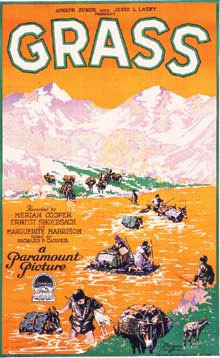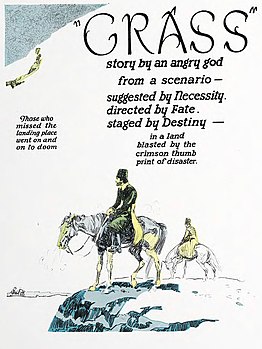Grass (1925 film)
| Grass: A Nation's Battle for Life | |
|---|---|
 Theatrical release poster | |
| Directed by | Merian C. Cooper Ernest B. Schoedsack |
| Written by | Terry Ramsaye |
| Produced by | Merian C. Cooper Ernest B. Schoedsack |
| Starring | Merian C. Cooper Ernest B. Schoedsack Marguerite Harrison Haidar Khan |
| Edited by | Terry Ramsaye Richard P. Carver |
| Music by | Hugo Riesenfeld |
| Distributed by | Paramount Pictures |
Release date |
|
Running time | 72 minutes |
| Country | United States |
| Languages | Silent film Intertitles |
Grass: A Nation's Battle for Life is a 1925 documentary film[1] that follows a branch of the Bakhtiari tribe of Lurs in Persia as they and their herds make their seasonal journey to better pastures. It is considered one of the earliest ethnographic documentary films.[2] In 1997, Grass was selected for preservation in the United States National Film Registry by the Library of Congress as being "culturally, historically, or aesthetically significant."[3][4]
Production[edit]
The film was directed and produced by Merian C. Cooper[1] and Ernest B. Schoedsack,[1] with intertitles by Richard Carver and Terry Ramsaye. It was the first film produced by the team of Cooper and Schoedsack, who went on to produce King Kong and many other films. Cooper was a writer performing research for the American Geographical Society and Schoedsack was a cameraman.[citation needed]
Reporter and former spy Marguerite Harrison was an instrumental member of the production team. Harrison had met Cooper at a ball in Warsaw,[5] and she provided him with food, books and blankets when he was taken prisoner by the Russians in 1920 and sent to work in a prison camp.[6][7] Harrison also appears in the film as herself. Years later, Schoedsack commented that Harrison had not done "a damn thing" during the expedition.[8]
Funding was provided by a loan of $5,000 from Cooper's father and brother, and Harrison contributed an additional $5,000.[9]
In filming the journey, Cooper, Schoedsack, and Harrison became the first Westerners to make the migration with the Bakhtiari.[9] The only previous ethnographic documentary was Robert Flaherty's Nanook of the North (1922). According to Cooper, the filmmakers were unaware of Nanook until their return to New York City from filming in Persia.[10]
Summary[edit]
The film's producers were mainly concerned with documenting a way of life that was unknown to all those outside the Bakhtiari realm. The film highlights the extreme hardships faced by nomadic peoples, as well as the bravery and ingenuity of the Bakhtiari on their migration in search of grass, which meant abundant seasonal pasture for their animals.
Grass documents the caravan route from Angora (modern-day Ankara, Turkey) to the Bakhtiari lands in Persia (western Iran in Chaharmahal and Bakhtiari Province and the eastern part of Khuzestan). The film then follows Haidar Khan as he leads 50,000 of his people and countless animals on a harrowing trek across the Karun River and over Zard Kuh, a subrange of the Zagros Mountains.
Reception[edit]

In a contemporary review for The New York Times, critic Mordaunt Hall wrote: "It is an unusual and remarkable film offering, one that is instructive and compelling but in no way a story. There is drama interspersed with captivating comedy, and the audience last night applauded some of the wonderful photographic sequences and at other times they were moved to laughter by the antics of the animals."[11]
The film was first shown at The Explorers Club annual dinner held at the Hotel McAlpin in New York City on January 24, 1925, along with a lecture by Cooper.[12] The Explorers Journal reported: "It is Mr. Cooper's happy achievement to have portrayed poignantly and comprehensively the drama of a people in their primitive struggle with inexorable forces of nature. The pictures were a fitting climax to an evening of thrilling entertainment."[13]Grass was later purchased for distribution by Paramount Pictures. Its theatrical debut took place at the Criterion Theatre in New York on March 30, 1925.[14]
Planned remake[edit]
In 1947, Merian C. Cooper sought to remake Grass, which he called a "damned half picture," and he said: "One man and one woman, and their children, will exemplify for the audience the whole of this struggle for survival which breeds a race that is proud and strong, rugged individuals all, meeting bravely the moods of natural forces seemingly bent upon their destruction."[15] Ernest B. Schoedsack told him to forget the idea because his Persian friends had informed him that a rail line now ran through the country, and much of the Bakhtiari's trek was now performed using cars and trucks.[16]
Reissue[edit]
Grass was reissued theatrically in the early 1990s. Rights to Grass had been donated to the Museum of Modern Art, and Milestone Film and Video obtained the rights in 1990.[17] Dennis Doros of Milestone said:
Out of the one hundred and fifty to two hundred films we've done, Grass and Chang are among the ones I am most proud of distributing. Chang is a national treasure in Thailand. Grass has images of race and culture that don't exist anymore, it's been called the greatest migration in modern history, and I agree. The journey of the Bakhtiari is so astonishing, the power of those images is like a dream, the way they're constantly moving and climbing.[14]
Grass has been issued in videocassette and DVD format.[18] It is also available for streaming on the Criterion Channel.[19]
In 2009, author Bahman Maghsoudlou published a book titled Grass: Untold Stories that includes background information and historical references related to the making of the film.[20]
References[edit]
- ^ a b c Hall, Mordaunt (April 30, 1927). "Chang A Drama of the Wilderness (1927)". The New York Times.
- ^ "Part 1: Grass: A Nation's Battle for Life & 124 CosmoLearning Anthropology". cosmolearning.org. Retrieved June 25, 2017.
- ^ "Complete National Film Registry Listing". Library of Congress. Retrieved April 30, 2020.
- ^ "New to the National Film Registry (December 1997) - Library of Congress Information Bulletin". www.loc.gov. Retrieved June 23, 2020.
- ^ Brin, David. (2005) King Kong Is Back!: An Unauthorized Look at One Humongous Ape, BenBella, ISBN 1932100644
- ^ Brownlow. 2005
- ^ Wakeman, John. (1988) World Film Directors. NY: W.H. Wilson, ISBN 0824207572, p.148
- ^ Marguerite Harrison profile Archived March 11, 2016, at the Wayback Machine, imdb.com, retrieved April 13, 2008.
- ^ a b Harrison, Marguerite "There's Always Tomorrow" 1935 Farrar & Rinehart ASIN:B00085QALK
- ^ Behlmer, Rudy (1965), Grass DVD, Special Features: Merian C. Cooper- Rudy Behlmer Interview
- ^ Hall, Mordaunt (March 31, 1925). "THE SCREEN". The New York Times. p. 17.
- ^ Explorers Club annual dinner invitation in Cooper scrapbook, vol. 1 box 49, Copper Papers, BYU.
- ^ Explorers Journal, vol. 4, Jan-March 1925, Box 49, Cooper Papers, BYU.
- ^ a b Vas,Mark 2005 Living Dangerously: The Adventures of Merian C. Cooper, Creator of King Kong, Villard First edition (August 2, 2005), ISBN 9781400062768.
- ^ "Grass" outline, Dec 17, 1947 p.1 MSS 1849, box 13, folder 8, Cooper Papers BYU
- ^ Kevin Brownlow, interview with Ernest B. Schoedsack from cassette tapes of sessions with Merian C. Cooper, circa late 1960s, made available to the author Mark Vas by Kevin Brownlow.
- ^ www.moviediva.com http://www.moviediva.com/MD_root/reviewpages/MDGrass.htm. Retrieved September 14, 2017.
{{cite web}}: Missing or empty|title=(help)[title missing] - ^ "GRASS: A NATION'S BATTLE FOR LIFE (DVD) | Film Threat". November 22, 2005. Retrieved December 18, 2021.
- ^ "Grass: A Nation's Battle for Life". The Criterion Channel. Retrieved December 18, 2021.
- ^ Maghsoudlou, Bahman (2009), Grass:Untold Stories
External links[edit]
- Grass essay by Dennis Doros on the National Film Registry website [1]
- Grass essay by Daniel Eagan in America's Film Legacy: The Authoritative Guide to the Landmark Movies in the National Film Registry, A&C Black, 2010 ISBN 0826429777, pages 97–99 [2]
- Grass clip (20:47) at the Internet Archive
- Grass at IMDb
- Grass at AllMovie
- Grass at the TCM Movie Database
- Grass at the American Film Institute Catalog
- 1925 films
- American silent feature films
- Black-and-white documentary films
- American documentary films
- Films shot in Iran
- United States National Film Registry films
- Documentary films about Iran
- Films directed by Ernest B. Schoedsack
- Films directed by Merian C. Cooper
- Anthropology documentary films
- 1925 documentary films
- American black-and-white films
- 1920s American films
- Films scored by Hugo Riesenfeld
